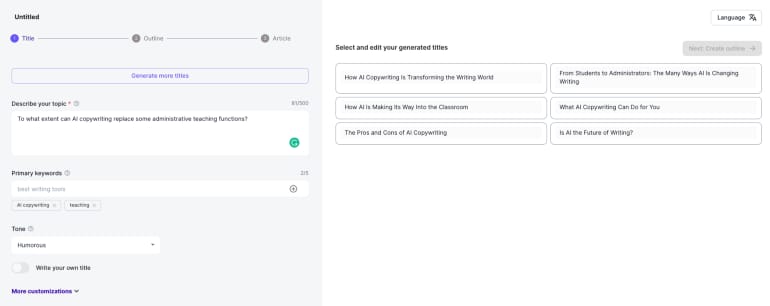- String
- Posts
- Can AI copywriting tools replace us (teachers) in writing qualitative comments?
Can AI copywriting tools replace us (teachers) in writing qualitative comments?
What is the role, function and usefulness of artificial intelligence in writing

Can AI copywriting tools replace us (teachers) in writing qualitative comments?
Whether it is testimonial writing or termly feedback for students, what is the role, function and usefulness of tech in writing?
To spare you the suspense, yes, AI copywriting can replace us in writing simple, generic qualitative comments. It will always struggle with deep personalization since us educators have intimate knowledge of what students are like. That will always be tough to replace. Arguably, we should not even bother to try to replace that because that would be ill-spirited.
This article will propose that AI copywriting be treated as a writing assistant rather than a replacement which has the potential to offload teachers by being an extra pair of eyes and hands. It will also explain some ‘pitfalls’ to lookout for and how especially general writing tutors can guard against being on the receiving end of AI written work.
Where is AI copywriting in my life?
We actually interact with it more often than we think. Spellcheck, autocorrect, grammar check are more popular uses of Artificial Intelligence (AI) in writing. Perhaps you already have Grammarly as a Chrome extension, grown too comfortable with autocorrect on your phone or are already all too familiar with the red squiggles on Microsoft Word that you do not notice. But the use case of AI could extend far beyond beyond the familiar.
Britannica defines AI as: “the ability of a digital computer or computer-controlled robot to perform tasks commonly associated with intelligent beings.” Essentially, we can train models to replicate the way we construct sentences and check for linguistic norms and rules.
For the latter, it is fairly straightforward (skip ahead for the more exciting bits):
Copy.AI
Copy.AI speeds up content creation workflow in a fairly user-friendly manner. Used primarily for generating marketing copies efficiently,
Suggested use cases
Supplementing termly feedback and generating generic comments about student behavior, using the adjectives as a starter
Attempt at generating qualitative comments about people
Copy.ai’s explainer:
Hypothenuse.AI
This was very fun to use. The founder Joshua Wong is Singaporean (yay local startups) and Hypothenuse began by simplifying marketing and sales related copywriting work. You can see the image below which describes its main business proposition back in 2020:

Image from Hypothenuse.ai. Full article by TechCrunch (2020)here
The product offering by Hypothenuse.ai has vastly expanded since to include fact checking, bulk content generation, blog articles, ads as well as direct e-commerce integration with platforms like Shopify.
I tried hypothenuse.AI to write an article and went through the following steps:
Generate a title:

2. Generate an outline:


I was actually very happy with the first one I got but thought the second one could very well fit the bill too so I went with the second one
3. Generate an article:

I ended up generating this article. Not sure how many could/ would guess on the first read. Honestly
Referral Signup link (bonus credits for us both)
Suggested use cases
English teachers could challenge their own students, after a graded writing exercise, to see if their writing quality was superior to AI. They could also critique the AI piece (feel free to use mine above if you would like) as a lesson
Discussions on prompts such as: how do I know if a piece was written by AI; on ethics of using AI to write or even grade essays — what problems may arise?
Testimonial Writing Assistant
Testimonial Writing Assistant is an experimental trained on past writing samples in an attempt to create a writing assistant for the specific function of affirming character traits and experience of students in school setting.

No fancy front-end/ user interface unlike the tools above (teachers genuinely dying to survive day-to-day and creating digital products is often nothing short of a miracle) but essentially this tool involved the following steps/ considerations:
Cleaning and preparing past data to use as training set. This is much more tedious than it sounds
Decomposing the anatomy of a testimonial (finding patterns in each paragraph — I would say the first and last has an especially clear method to madness)
Training the model. This is where the fun begins
Accommodating user input (see below for examples):

It is not the developer/ product owner’s intention to subvert the entire writing process. Part of the design of the product involve some manual input to
Suggested use cases
Attempt to train the model using your own writing style/ dataset
In instances where one may struggle hard to write, this could provide a base to work off
Technical notes
GPT-Neo instead of GPT-3 used because free
GPT-Neo was trained as an autoregressive language model. This means that its core functionality is taking a string of text and predicting the next token.
Next steps
Creating a front end and allowing end-users to train their own model based on their own data sets
Creating participation endpoints — can help schools train and deploy their own models to explore their use case! Leave a comment here or drop me a message on linkedin(:
Hope this covers some use cases and prompts more adoption of AI in teaching and learning :)
And yes, no AI used to churn the structure or content for this piece. If you enjoyed it feel free to leave a comment!